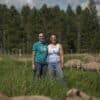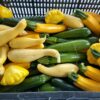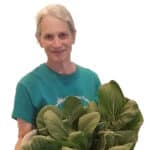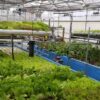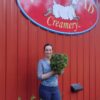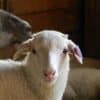You’re Milking What?

All good stories start “a long time ago…” which, when you’re a mature 23 years of age, eight years of hard work, study, and dedication seems like one of those legendary ages. And, just like many of those great epic journeys, it starts in a very different place than it ends. This is because our voyage into dairy sheep (oops, am I giving it away?) started with alpacas…or the lack thereof.
While my foray into farming began with the feathered dinosaurs we commonly call chickens, my sister Kara’s passion for animals great and small began with a yearning for alpacas. She was learning to spin and knit, and alpaca fleece is treasured for being hypoallergenic, incredibly soft, and amazingly warm. These long-legged camelids—which are often shorn leaving fluffy heads and legs—are gentler cousins of llamas and originate in South and Central America. However, just as the yearning for parakeets and cockatoos never quite manifested into reality, the interest in expensive alpacas was channeled into a different route.
We were new members of 4-H at the time, working on projects in fiber arts, bees, and…here it comes: sheep. The $2,000 to $10,000 a piece alpaca pair was reborn as a-$60 a-piece couple of sheep. Kara’s first wooly companions were a young ewe (said “you”) named Sweet and a whether (neutered male) named Heart—an inseparable and friendly pair. Sweet, a purebred Hampshire sheep, gave many sets of triplet lambs as our adventures grew into embracing the ovine birthing process. With the aid of a growing personal library and Mom’s medical skills as a physician, Kara’s veterinary talents blossomed. This last spring, the entire south wing of the restored 1919 barn served as the nursery, with numbered birthing pens called “jugs” accompanied by detailed records of age, weight, vaccinations, and tagging. We call it “the maternity ward.”
With sheep come many adventures, like learning to bale hay with put-put 1940’s equipment (little squares, no kicker…if you’ve made hay, you know what I’m talking about). There’s shearing time when all the thick, wooly coats come off, leaving slim goat-shaped creatures that look at you like “What?” And there’s the occasional Houdini sheep who loves to escape from the fence and go on little adventures to the flower beds and other such interesting places. Oh, sorry Grandma, I guess we weren’t supposed to tell you about that one…
But sheep are not goats. Not that I have anything against goats, but let’s be clear. Over the last year, I’ve been plagued by folks who don’t know the difference between a sheep and a goat. So here’s a little lesson to put you in the know, and maybe it will be useful at your next cocktail party…who knows? Sheep and goats and cows are in a special family of mammals called ruminants. This name comes from the fact that they have multiple stomachs (usually four) to help them digest more of the nutrients in grasses. Pigs and horses only have one stomach, like people. The rumen process makes these particular animals extremely efficient in pasturing systems because grassy “fodder” is exactly the type of food their unique biology has developed to eat. Goats are excellent foragers of stalky and brushy material, making them excellent for hilly and mountainous areas that are difficult to hay. Sheep love flat or rolling countryside and lush grass mixed with clovers. A well-maintained sheep pasture looks very much like a golf course—only minus the chemicals and the motorized lawn mowers.
Also, sheep are actually more closely related to deer than goats. When I’m asked what lamb tasted like, the closest comparison might be non-gamey venison, rather than liking it to beef. And, no, a goat is not a female sheep, as I was once informed at a gathering. A female sheep is a ewe, while the male is a ram. And, actually, there are more sheep milked worldwide than cows. What? Milking sheep? Really?
Like all mammals, sheep give milk. And like all ruminants, they do this via an udder (only this one has two spigots instead of four). In France, the Lacone sheep is prized for its milk, which is used to make artisan cheeses, while in Germany, the breed of standard is the East Friesian. Kara grew interested in dairy sheep after attending conferences at the UW Dairy Sheep Research Station in Spooner, the only one of its kind in the U.S. The cold winters, however, make life difficult for the French and German dairy sheep breeds, so Kara began the arduous process of cross-breeding to mix in hearty English, Welsh, and Finnish stock with the Continental favorites. In the process, we have had tall sheep, short sheep, black-faced sheep, white-faced sheep, and speckled sheep—all with their own personalities and names.
As the genetic side of the dairy process grew, Kara visited and interned at different dairy sheep farms to learn tips and experience new methodologies. Through this process, she learned from artisan cheesemakers and studied at the Babcock Institute in Madison to acquire the finer points of ice-cream production. But, in the end, it was a new, gourmet product that was calling her—gelato. If you’ve been to Italy, you probably ate your way across the country from one gelateria to the next. But for those who haven’t made that trek, gelato may be a new phenomenon. Made fresh, served warmer, and churned with less air in it, gelato is a creamy and heavenly treat that surprises your taste buds with its bounty of flavor. Also, ice cream is made with a butterfat content between 12 and 16 percent, while gelato is made with a butterfat content between 6 and 8 percent—which is just how it comes out of the sheep.
To continue her journey, Kara studied with master Italian gelato makers on Long Island through the Gelato and Pastry Institute of America, where she developed a recipe to make her own gelato base from scratch (instead of buying a pre-made base). In her newly-completed dairy plant at Farmstead Creamery & Café, Kara whirs about like a master artist in her studio—blending hand-crafted chocolate paste, nut butters, or Bayfield blueberries to make richly rewarding waves of creamy gelato. Every scoop is a work of art.
From the gentle pastures on our family’s farm, to the softly bleating ewes coming out of the parlor, to the frothy white milk in the old-style can, and finally the swirled gelato in your home-made waffle cone, this truly is an epic journey of love and care, passion and dedication to the best of all worlds. It’s a story that connects you with the people and the place where real food comes from, fresh off the farm. So next time someone asks you, “They’re milking what out there?” you’ll know a little more of the story.
And, just in case you might have forgotten, it’s sheep, not goats. See you down at the farm sometime.

